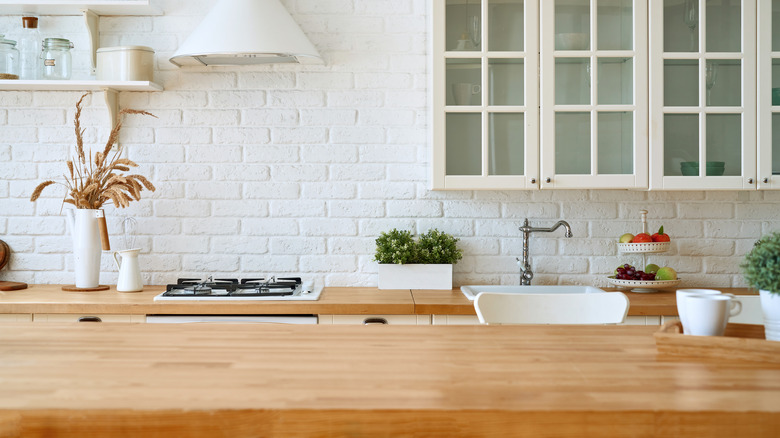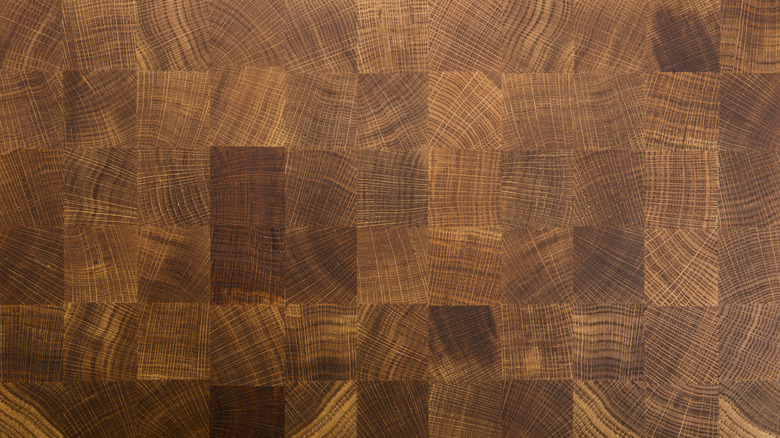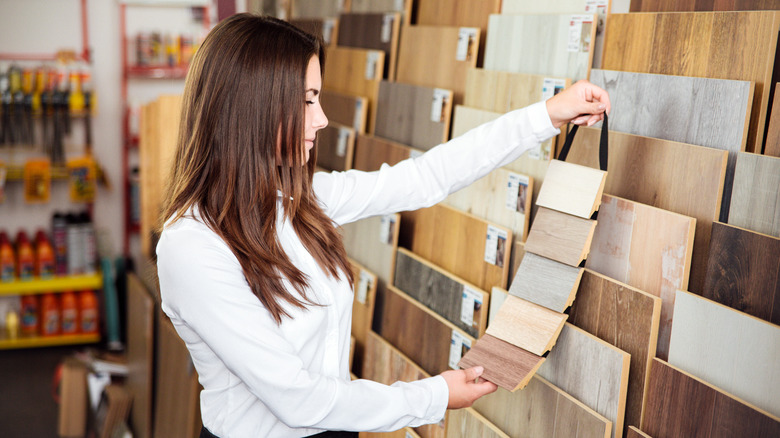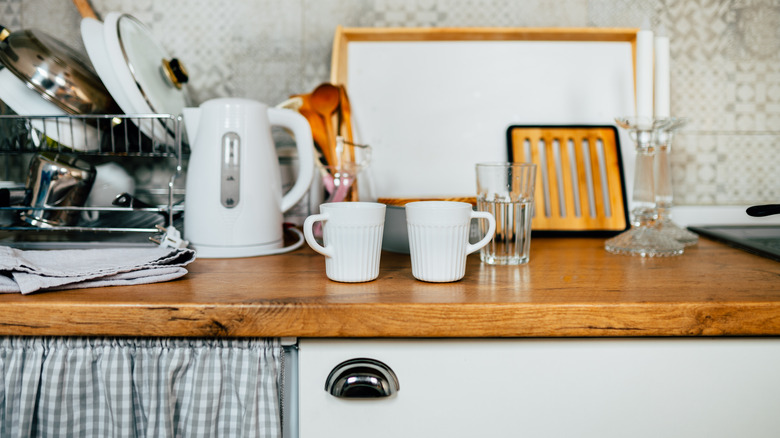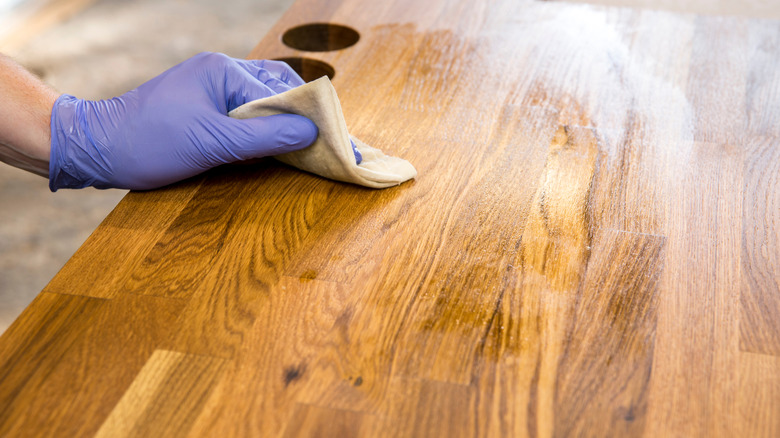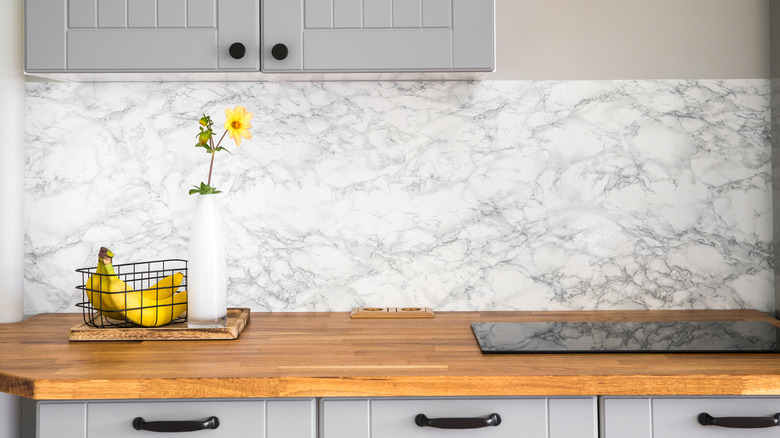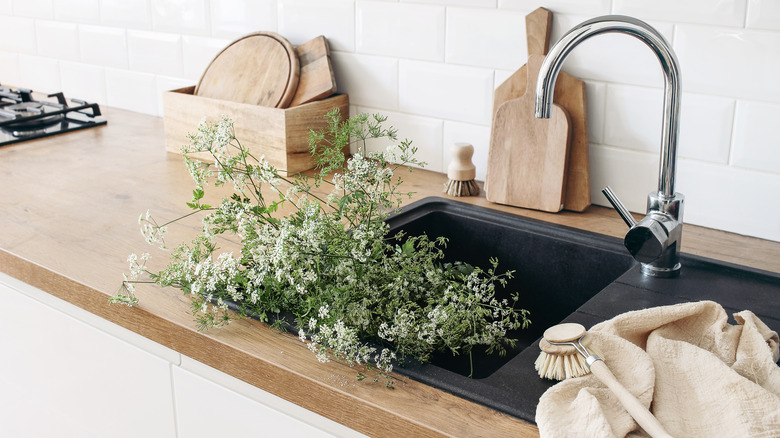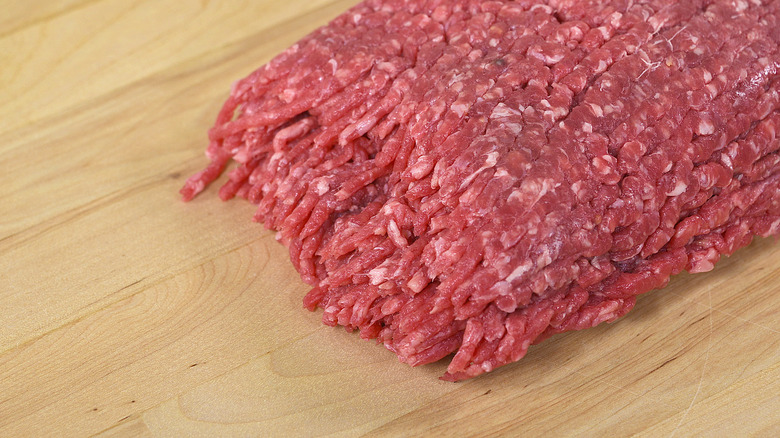Butcher Block Countertop: What To Know Before You Buy
Say you're undertaking a kitchen renovation, and it's time to revamp your countertops. Apart from perhaps the cabinets, countertops are one of the biggest focal points of the kitchen and can give the space a fresh new feeling. After careful consideration of all the different types of countertops on the market, you choose to go with a butcher block countertop. While particular materials fall in and out of vogue, butcher block counters have remained popular throughout the years thanks to their timeless appeal and warm aesthetic. The natural beauty of the wood complements many different colors and materials, making butcher block countertops relatively easy to match to existing cabinets and flooring. They look great with everything from white kitchen designs to all-wood kitchens.
However, as with any remodeling aspect, there are several things to consider before pulling the trigger. What type of butcher block wood would be the best fit for your kitchen aesthetically? How do you want the wooden boards arranged on your countertop? Do you have to consider any particular maintenance requirements? Or, as Southern Living recommends speculating, do you want to incorporate different countertop materials in different areas of your kitchen? For example, you can use butcher block on just your kitchen island and quartz everywhere else. If your heart is set on butcher block countertops, here are a few handy things to know before you make the purchase. After all, it needs to be the right fit for you and your space.
1. The construction styles available
When it comes to the types of butcher blocks available, one of the key things to consider is the construction style. It makes a major impact on the overall look of the countertops, so you'll want to evaluate your options carefully. Each style has its pros and cons, but ultimately it's simply a matter of preference. As Remodelista explains, there are three basic butcher block countertops: end grain, edge grain, and face grain. The style details how the butcher block surface is put together and how the wood is laid out.
Edge grain is created by using, as the title suggests, the "sides" of boards. Long wooden boards are placed on their sides and joined together, creating a countertop comprised of their edges. The long, continuous lines of the wood boards can help create the illusion of length, which may be a bonus in smaller kitchens. This is the cheapest option of the three. Face grain is the opposite, with a surface created by laying boards flat for wide planks. While it can be stunning visually, this style can be a bit more susceptible to marks if you use your butcher block countertop as a cutting board. Finally, end grain is created by arranging small blocks taken from the end of each plank, creating a signature, almost checkerboard appearance. This is the most expensive option of the three.
2. The colors available
While there aren't as many color options for butcher blocks as for other materials like tiles or stone, there is still an impressive variety, all of which can showcase the beauty of natural wood. When choosing the color, you first need to consider the type of wood. As Country Living explains, you can choose between options like maple, oak, cherry, acacia, teak, walnut, and more. The price and density vary from type to type, with maple being the densest and thus one of the most durable options. It is also one of the most affordable options, whereas cherry and walnut are pricier. Each wood has a natural hue, such as the signature reddish tint found in American cherry wood or the warm, rich tones of walnut.
Staining is also an option if you decide to go with a more economical cut or are refinishing old butcher block countertops and desire a different look. Before staining, Home Depot recommends preparing your countertops by filling in cracks and seams, sanding, and conditioning the surface. Then you can brush on your stain color of choice. Most wood stains come in shades that mimic the colors found in natural wood, so you can potentially mimic the look of a high-end wood for a more budget-friendly price by using stain.
3. Average investment
As with any material, the price range for getting butcher block countertops installed in your kitchen will be heavily dependent on the exact materials you select, and there is a fair bit of variation. But choosing the cheapest option might not be a wise investment. Be careful when looking at butcher block countertops on the very low end of the cost spectrum, even if you're a budget-conscious shopper. As Architypes reports, there are certain big-box stores such as IKEA where you can find "butcher block" countertops for as little as $10 per square foot. However, those countertops are likely crafted from particleboard with wood veneer rather than actual wood. If it's real butcher block you're after, you don't want to get fooled by those materials. On the opposite end of the spectrum, if you select an exotic wood or something artisanal that's been prepared by a local craftsman rather than a larger manufacturer, you may be looking at a price tag as high as $200 per square foot.
According to Home Advisor, the average cost will be between $40 to $100 per square foot, which includes both the price of the materials as well as the price of installation. There are certainly other elements that may add to the price tag, such as custom cuts or sections to accommodate a certain kitchen layout. Still, the average price will give you a starting point that you can use to calculate the entire project.
4. Pros of butcher block countertops
There are many pros to butcher block countertops, the first of which is its lasting appeal. As O'Hanlon Kitchens, Inc. explains, wood is a material that just never goes out of style, and if you want to update your kitchen in the future, you can always stain the countertops a different color. You won't have to gut the kitchen and replace everything the way you would with a different type of countertop. This means you won't be stuck with a material that looks hopelessly outdated 10 or 15 years down the road.
While it's not as durable as quartz or marble, butcher block countertops are relatively easy to fix if wear and tear occur. If you see a few scratches, nicks, or stains as time passes, you can sand away damage during your regular maintenance. Or, if it's bad enough, you can even consider refinishing the countertops to get a brand new surface. You also don't need to worry about particular food groups like citrus, which can wreak havoc on certain stone countertops, as Hunker says.
Environmentally-conscious homeowners will also be happy to hear that butcher block is a sustainable option. In contrast, granite and marble are non-renewable resources that require lots of energy and resources to be quarried, according to QPC & C, a quantity surveyors firm.
5. Cons of butcher block countertops
One key thing to consider with butcher block countertops is how susceptible they are to moisture and water. As Bob Vila explains, moisture exposure can cause butcher block counters to warp, stain, collect germs, or even grow mold. You'll want to be mindful around areas like the sink and keep a close eye on your drying rack and drying mat. You don't want that moisture lingering for extended periods on your countertops.
Additionally, while butcher block is easy to clean, it does require regular maintenance. Remodelista suggests oiling your countertops once every six months to keep them from drying. However, this is just a general rule of thumb. If you're a devoted cook who spends a ton of time in the kitchen, you may need to refinish the countertops more often.
Finally, if you like to constantly cook large meals, want countertops that are as user-friendly as possible, or counters that don't require a lot of care, then butcher block counters might not be for you. Wood isn't heat resistant, which means you can't simply set a hot pot or pan straight on the countertop like you would with some stone surfaces. You'll want to have a trivet or pad underneath to protect the countertop.
6. How long does butcher block last?
New countertops can be quite an investment, especially if you have a large kitchen with plenty of counter space. Thus, you want to make sure you choose a material that you won't need to replace in five, or even 10, years. Luckily, butcher block is an incredibly durable material that will stand the test of time with proper care and maintenance.
According to Hardwood Lumber Company, butcher blocks can last about 20 years. However, that number might be a bit conservative. How to Look at a House, a home inspection blog, claims that butcher block counters can last up to 60 years if they're well cared for and properly maintained. Anyone who has ever admired the well-worn, cozy appearance of butcher block countertops in a cottage or an older property knows just how true this can be. Plus, the unique ability of butcher block counters to be resanded or refinished means you can freshen their appearance whenever you need to.
Overall, if longevity is one of your priorities when it comes to your countertops, butcher block may be a strong contender. With a little bit of TLC, it may very well outlast your time in a house.
7. What kind of cleaning and maintenance does it need?
So, now you know that butcher block countertops require some degree of maintenance in order to properly last. However, you might not be sure what that entails. Don't worry, there are just a few simple things to remember to keep yor countertops looking amazing for decades. First of all, don't let any pesky stains or spills linger for too long. Homes.com warns stains could potentially penetrate the wood, so clean any spills quickly. To clean the countertops, Build Direct suggests washing them with dish soap and hot water, and wiping away all the moisture afterward with a microfiber cloth. To disinfect the wood, using simple white vinegar is enough.
In terms of maintenance beyond just daily cleaning, you'll want to ensure that you're periodically oiling your countertops so the wood doesn't crack or splinter due to dryness. While there are many products out that will get the job done, just make sure you've selected a food grade oil that works well with butcher block, such as a mineral oil or walnut oil. Alternatively, if you prefer your countertops to have a bit more of a sheen, you may want to also use a conditioner containing beeswax.
8. The history of butcher block
It can often be helpful or simply interesting to learn more about what a particular material or surface was used for. Sure, you've seen gorgeous photos of well-designed kitchens with butcher block countertops gleaming in the natural sunlight, but do you know what the history behind this particular material is? As McClure Block explains, butcher block was originally a countertop used for meat processing. Because it jointed a variety of strong wooden pieces together, the block could withstand more wear and tear from knives than a simple slab of wood. The butcher block countertop industry began in the 1870s, with two Midwest companies producing most pieces. These companies slowly refined the process of transforming wood into durable countertops. Initially, they used sycamore logs and then evolved into using jointed strips of maple.
If you're looking to keep your countertops looking great for decades, you'll want to avoid taking a page from the history books and chopping food right on the countertop. Even though you can use your countertops as a cutting board if necessary, it can reduce their longevity. To avoid that, keep around a butcher block cutting board for carving all your carnivorous creations.
